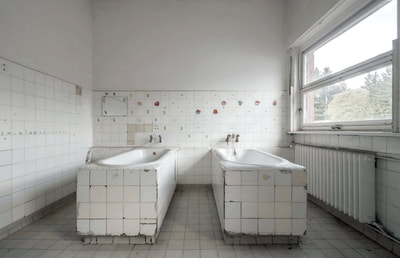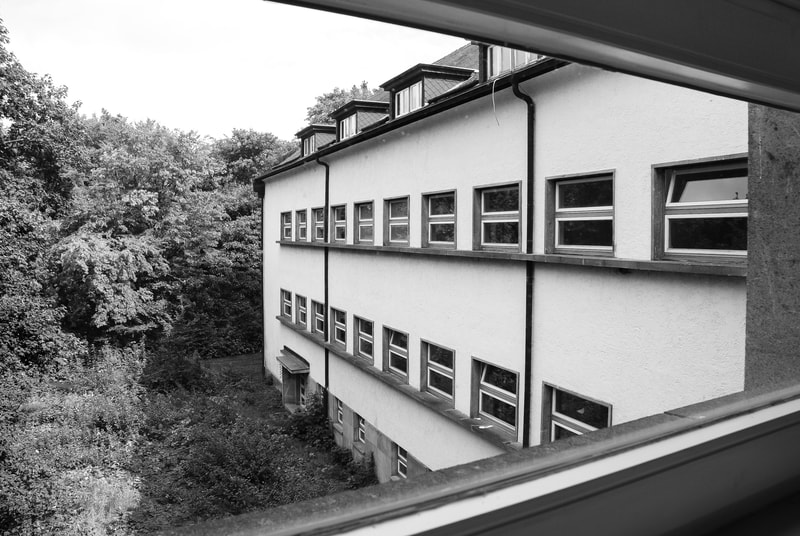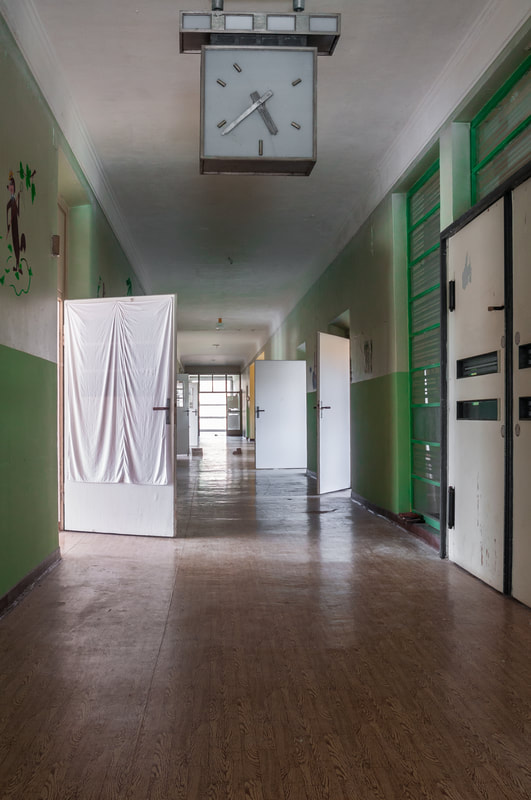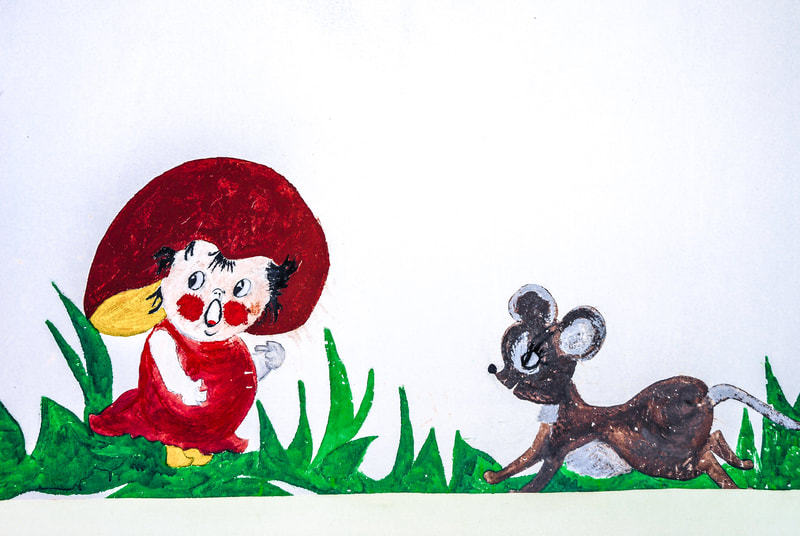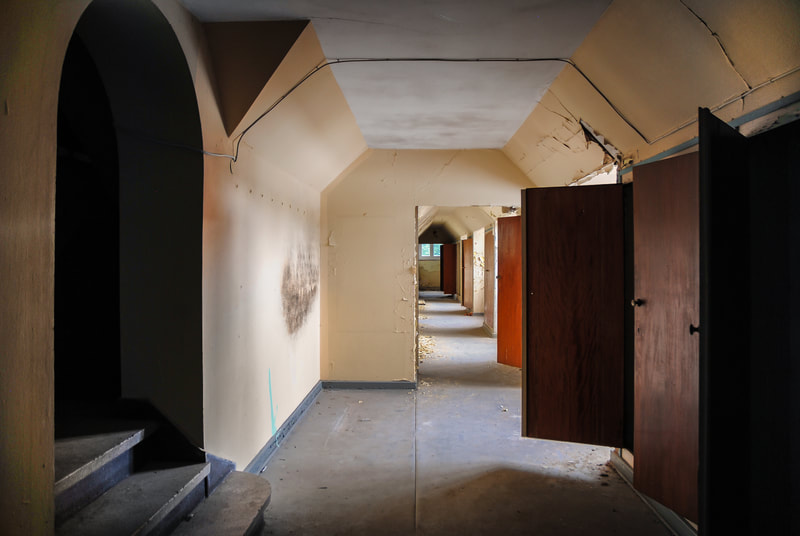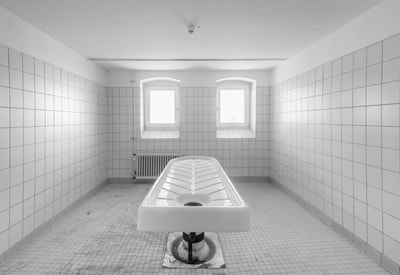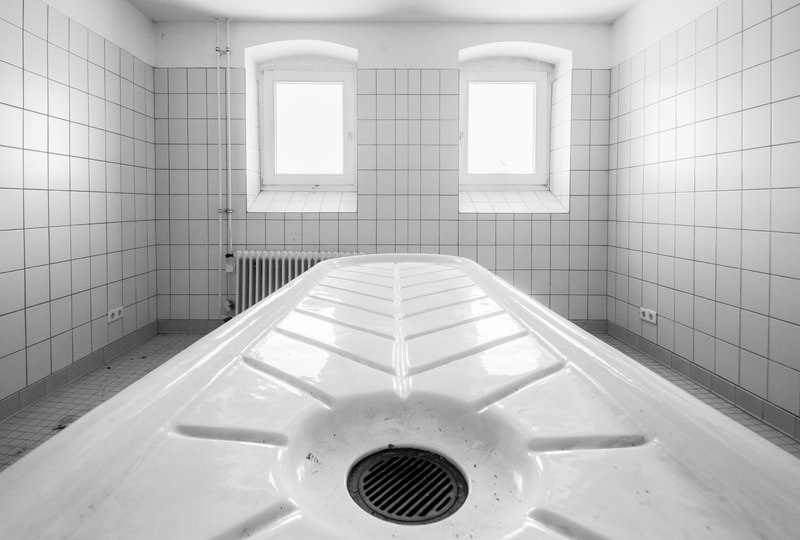Harzwaldklinik
Die Kinderheilstätte für Lungen- und Bronchialkrankheiten, vorrangig auf die Behandlung von Lungentuberkulose spezialisiert, wurde in den 1920er Jahren in Harzgerode im Bauhausstil errichtet. Zum Ensemble gehörten das Klinikgebäude an sich, zwei Ärztehäuser nebst Chefarztvilla, eine Isolationsstation, ein kleines Schulgebäude sowie eine eigene Gärtnerei. Insgesamt gab es Platz für 150 Patienten. Im Jahr 1998 wurde die Heilstätte endgültig geschlossen. Seitdem gab es immer wieder diverse Versuche das Areal zu revitalisieren.
Aktuell hat das Sanatorium neue Eigentümer, die in einer alternativen Lebensgemeinschaft auf dem Gelände wohnen. Das Areal wird seitdem rund um die Uhr bewacht, sowohl von den neuen Bewohnern selbst, als auch via Kamerasystem. Besucher sind jedoch nach vorheriger Anmeldung willkommen.
Zwei Besuche brachten mir die alte Klinik näher. Den ersten Besuch statte ich der Lungenklinik bereits im Jahr 2011 ab. Der damalige Eigentümer, der einen Ponyhof errichten wollte, genehmigte uns damals den Aufenthalt. Leider stellte sich sein Projekt am Ende als unrentabel heraus. Während unseres Aufenthalts machten wir auch Bekanntschaft mit einer treuen Seele, die unsere Erkundung äußerst spannend fand und uns Stockwerk um Stockwerk, gerne lauthals, durch das alte Sanatorium folgte. Kaum hätte ich damit gerechnet dieselbe Katze - fünf Jahre nach meinem ersten Besuch - wieder zu treffen. Irgendwo, mitten in den Korridoren des Krankenhauses, ertönte plötzlich ein lautes Bellen. Kurz bevor meine Besorgnis stieg einen schlecht gelaunten Hund zu treffen, kam die treue Weggefährtin von damals um die Ecke. Ich konnte es kaum glauben. Hatte das Gelände auch die Eigentümer seit meines letzten Besuchs gewechselt, so blieb der Hauswächter doch der Alte. Somit ging es nun ein zweites Mal, mit zeitweiser Begleitung meines vierbeinigen Freundes, durch das Gebäude.
Dieses Mal blieb mir auch der nüchtern weiß gekachelte Raum der ehemaligen Pathologie nicht verborgen: mit nichts darin als einem ebenso nüchtern wirkenden Porzellantisch. In Kindergröße. Auch Kinder sterben. Das war die, passend zum Ambiente, nüchterne Erkenntnis, die ich aus dieser Begegnung mitnahm. Die Krankenhauskorridore der Stationen hingegen, wurden mit vielen bunten Wandbildern verziert, um den Aufenthalt etwas heimeliger zu gestalten. Ein wirklich belebender Kontrast zu dem, was ich im Kellerbereich vorgefunden hatte. Heute wirken diese verwaisten Gänge jedoch auch eher gespenstisch. Die Gartenanlage des Krankenhauses war großzügig angelegt, besaß eine eigene Gärtnerei und einen künstlich angelegten Teich. Auch wenn das Areal mittlerweile eher verwildert ist, so kann man sich vorstellen, wie schön es hier einst gewesen sein muss.
Persönlich hoffe ich, dass man dem Gelände eines Tages wieder neues Leben einhauchen wird.
Aktuell hat das Sanatorium neue Eigentümer, die in einer alternativen Lebensgemeinschaft auf dem Gelände wohnen. Das Areal wird seitdem rund um die Uhr bewacht, sowohl von den neuen Bewohnern selbst, als auch via Kamerasystem. Besucher sind jedoch nach vorheriger Anmeldung willkommen.
Zwei Besuche brachten mir die alte Klinik näher. Den ersten Besuch statte ich der Lungenklinik bereits im Jahr 2011 ab. Der damalige Eigentümer, der einen Ponyhof errichten wollte, genehmigte uns damals den Aufenthalt. Leider stellte sich sein Projekt am Ende als unrentabel heraus. Während unseres Aufenthalts machten wir auch Bekanntschaft mit einer treuen Seele, die unsere Erkundung äußerst spannend fand und uns Stockwerk um Stockwerk, gerne lauthals, durch das alte Sanatorium folgte. Kaum hätte ich damit gerechnet dieselbe Katze - fünf Jahre nach meinem ersten Besuch - wieder zu treffen. Irgendwo, mitten in den Korridoren des Krankenhauses, ertönte plötzlich ein lautes Bellen. Kurz bevor meine Besorgnis stieg einen schlecht gelaunten Hund zu treffen, kam die treue Weggefährtin von damals um die Ecke. Ich konnte es kaum glauben. Hatte das Gelände auch die Eigentümer seit meines letzten Besuchs gewechselt, so blieb der Hauswächter doch der Alte. Somit ging es nun ein zweites Mal, mit zeitweiser Begleitung meines vierbeinigen Freundes, durch das Gebäude.
Dieses Mal blieb mir auch der nüchtern weiß gekachelte Raum der ehemaligen Pathologie nicht verborgen: mit nichts darin als einem ebenso nüchtern wirkenden Porzellantisch. In Kindergröße. Auch Kinder sterben. Das war die, passend zum Ambiente, nüchterne Erkenntnis, die ich aus dieser Begegnung mitnahm. Die Krankenhauskorridore der Stationen hingegen, wurden mit vielen bunten Wandbildern verziert, um den Aufenthalt etwas heimeliger zu gestalten. Ein wirklich belebender Kontrast zu dem, was ich im Kellerbereich vorgefunden hatte. Heute wirken diese verwaisten Gänge jedoch auch eher gespenstisch. Die Gartenanlage des Krankenhauses war großzügig angelegt, besaß eine eigene Gärtnerei und einen künstlich angelegten Teich. Auch wenn das Areal mittlerweile eher verwildert ist, so kann man sich vorstellen, wie schön es hier einst gewesen sein muss.
Persönlich hoffe ich, dass man dem Gelände eines Tages wieder neues Leben einhauchen wird.
The children's sanatorium for treating lung- and bronchial diseases, specialized in the treatment of lung tuberculosis, was built near the town of Harzgerode, Germany in the 1920s in the so-called Bauhaus style. It consisted of the main hospital building, the housing area for the medical staff including a villa for the chief medical officer, its own small school building as well as a gardener's house. Around 150 patients could be housed. The hospital was shut down for good in 1998. All tries to revitalize the area have failed so far.
Yet, the sanatorium has new owners presently who are trying to establish an alternative form of living on the grounds. Now, the area is monitored around the clock. There are cameras all over the place and the new owners are directly living on the premises. After previous inquiry visitors are welcome.
I have visited the old sanatorium two times so far. My first one took place in 2011 when there was the past owner who allowed us to enter the grounds in order to take photos. He tried to establish a pony farm for kids. Unfortunately, his project turned out to be unprofitable. Back in 2011, we were accompanied by a new friend - a nosy cat who followed us floor after floor through the old sanatorium. I would have never thought to meet that very cat again. During my last visit, five years after the first one, suddenly, somewhere in the maze of hospital corridors, we could hear loud barking. Shortly, before I really started to worry about that, the to me well known cat came around the corner. Five years after my first visit, I met it again. I was glad, that the cat was still there although the owners have changed over time. Thus, it was my pleasure that I had the opportunity to explore the building with my cat explorer once again. That time I was also able to take a look inside the small white-tiled room of the former morgue. Its view was pretty sobering. There was nothing more than an at least as sobering view of the porcelain mortuary slab - perfect kid-size - inside a small room. Also children die. It was the most sobering fact of the day. On the contrary, the corridors of the wards were decorated with lots of murals in order to help feeling a bit at home. A really stimulating contrast compared to the atmosphere of the basement area. Yet, the maze of corridors never fails to create a somewhat haunting atmosphere. The garden of the sanatorium was huge, contained greenhouses and even its own artificially constructed pond. Although, the area appears pretty wild nowadays, I can imagine how beautiful it must have been once.
I dearly hope that the old sanatorium grounds are going to be revived one day.
Yet, the sanatorium has new owners presently who are trying to establish an alternative form of living on the grounds. Now, the area is monitored around the clock. There are cameras all over the place and the new owners are directly living on the premises. After previous inquiry visitors are welcome.
I have visited the old sanatorium two times so far. My first one took place in 2011 when there was the past owner who allowed us to enter the grounds in order to take photos. He tried to establish a pony farm for kids. Unfortunately, his project turned out to be unprofitable. Back in 2011, we were accompanied by a new friend - a nosy cat who followed us floor after floor through the old sanatorium. I would have never thought to meet that very cat again. During my last visit, five years after the first one, suddenly, somewhere in the maze of hospital corridors, we could hear loud barking. Shortly, before I really started to worry about that, the to me well known cat came around the corner. Five years after my first visit, I met it again. I was glad, that the cat was still there although the owners have changed over time. Thus, it was my pleasure that I had the opportunity to explore the building with my cat explorer once again. That time I was also able to take a look inside the small white-tiled room of the former morgue. Its view was pretty sobering. There was nothing more than an at least as sobering view of the porcelain mortuary slab - perfect kid-size - inside a small room. Also children die. It was the most sobering fact of the day. On the contrary, the corridors of the wards were decorated with lots of murals in order to help feeling a bit at home. A really stimulating contrast compared to the atmosphere of the basement area. Yet, the maze of corridors never fails to create a somewhat haunting atmosphere. The garden of the sanatorium was huge, contained greenhouses and even its own artificially constructed pond. Although, the area appears pretty wild nowadays, I can imagine how beautiful it must have been once.
I dearly hope that the old sanatorium grounds are going to be revived one day.
Alte Fliegeraufnahme o. J. - Aerial view, year unknown
(private Sammlung - private collection)
Liegeterrassen, o. J. - Patient's balconies, year unknown
Altes Werbematerial - Old advertisement
(Quelle unbekannt - source unknown)






